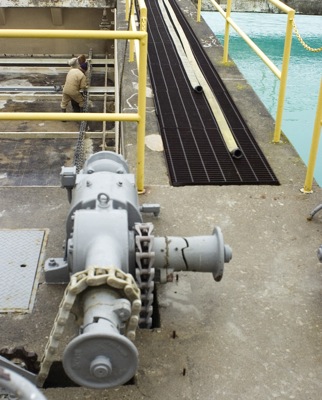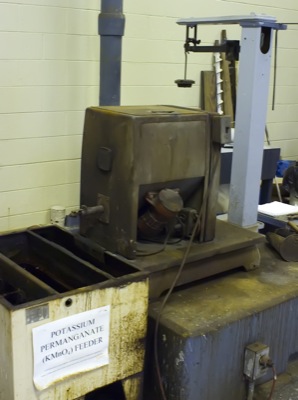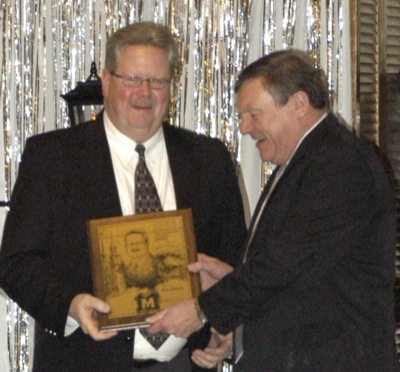Monday, February 23rd, 2009
Crew saves city money by doing repairs
By William Kincaid

Photo by Mark Pummell/The Daily Standard
Instead of outsourcing work, Celina Water Treatment Plant employees do many of the projects themselves, such as creating containment walls, adding new facility doors and steps and fixing old machinery.
Equipment at the Celina Water Treatment Plant dates back to the 1950s from companies no longer in existence, but Superintendent Mike Sudman and his crew of seven continue to make do with what they have.
And many times, instead of outsourcing repair work or purchasing new parts, the water plant crew do much of their work in-house, concocting methods to deal with electric, plumbing and equipment problems.
Their efforts have saved the city thousands of dollars over the years, according to Sudman and Celina Safety Director Jeff Hazel.
For instance, the last few years, the city probably saved $350,000 during construction of the $7 million Granular Activated Carbon facility by not having to hire an engineer to oversee the project. Sudman - with his knowledge of the plant - assumed those duties.
"I like my job," Sudman said, trying to downplay his contributions to the plant.
The original drinking water plant dates back to 1952 with additions made in 1962, 1975, 1990, 1994, 2000, 2004 and 2008.
During a tour of the water plant this week, Sudman showed the facility's two up-flow clarifers from 1974.
Raw lake water enters the plant through a concrete water intake structure, commonly known as a screen house, before entering the clarifers. The two clarifers never worked property when installed in 1974 as part of a $1.5 million project, and the company soon went out of business, leaving the city no options, Sudman said.
The equipment was supposed to both clarify and soften the incoming raw water. Sludge - algae, sediments, minerals, muck, fish guts, etc. - were intended to remain in the bottom of the clarifer.
But due to malfunction and an upflow of water, the sludge remains at the top, which forces employees to open a water retention pit behind the building that softens the clean water, Sudman said.
Employees, also annoyed with having to replace the clarifers' motors every year, made some changes to the motors and extended their lives by four years, Sudman said.
Sudman would like to have a pilot study done to determine if new clarifers would save the city money through reduced use of carbon, which absorbs organic material at the new GAC plant.
"Any organics I can remove here saves us dollars," he said.
The purchase and installation of new clarifers - which would require tearing off the roof - would cost up to $3 million. But if the city's annual $500,000 carbon cost could be slashed by $200,000 annually, it would be worth the cost, Sudman said.
Sudman said Celina Planning and Community Development Director Kent Bryan may submit the project idea to the state for federal stimulus dollars.
Plant workers do much other work by themselves, such as creating containment walls, adding new facility doors and steps and fixing old machinery, Sudman said.
The 1952 feeder of potassium permanganate - added to remove iron and manganese in water - has seen better days, Sudman also said.
"It should be replaced - we're making it work," he said, explaining a new feeder would cost at least $12,000.
Like most of the other equipment at the plant, parts are unavailable as the company that supplied the feeder is gone. Employees have replaced its timer and vibrator and used springs and washers to fix the machine, Sudman said.
Many employees learned from former plant operator Larry Derksen, who could modify or fix almost anything, Sudman said. Derksen, who recently retired, worked at the facility for three decades.
As for the rest of the crew, Sudman is confident they will stay at the plant.
"It's hard to leave here because we do pay decent," he said.
Other outdated machinery includes a lime shaker, a rusting machine that requires exhaustive, time-consuming cleaning every few weeks to remain functional, he said. Also, water mixers over 30 years old need replaced, as does one of the three primary pumps - a 1952 model - that releases water to the main line that provides the city clean water.
Though Sudman made a request, the item was removed from the 2009 city budget because of financial woes.
During the slower months of winter - such as now - the plant produces 1.3 million gallons of treated water for Celina each day. During the summer that increases to 1.5 million gallons a day. Sudman said the plant's highest output ever was 2.2 million gallons.
In the 55-year history of the current water treatment plant, a total of 18.875 billion gallons of water has been pumped into the city's distribution system, according to city records.

Photo by Mark Pummell/The Daily Standard
Celina water treatment plant employees continue to make do with outdated equipment, some more than 50 years old. Pictured is a 1952 feeder of potassium permanganate. Improvisations are often needed to keep machinery operational, plant employees say.



